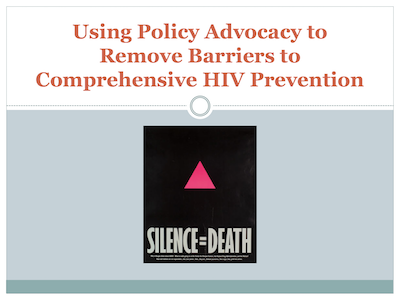Objectives for Module 4:
- Review a brief history of HIV/AIDS policy advocacy
- Understand basic tactics for policy advocacy and how it differs from other kinds of advocacy
- Go over suggestions for developing an advocacy agenda and action plan
- Discuss some of the primary options in our “advocacy toolbox”
The goal of policy advocacy is to change official policies, laws, and practices. It is different from the work of educating individuals or communities; rather than advocating for broad community understanding or behavior change, with policy advocacy we are specifically looking for people in positions of power to amend, eliminate, or create laws and policies that will better support our efforts. Through these efforts, we can create change that is impactful, lasting, and farther reaching than an educational campaign. It’s about demanding that people and institutions in power do some of the work for us, rather than burdening communities with the endless task of education and adaptation.
In Module 4, we look at the legacy of HIV advocacy that has improved the quality and accessibility of care, treatment, and prevention services over time. We also discuss how to prepare for policy advocacy in HIV prevention, how to develop policy advocacy action plans that include clear objectives and targets, and the use of advocacy/activist tools to persuade people in power to change policy. Our focus is HIV prevention policy advocacy, though many of the tips here can apply to other causes.
Special Thanks to Jeff Graham at Georgia Equality and Melanie Medalle at SisterLove, Inc. for their many insights on policy advocacy education.

